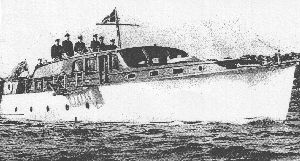- Author
- Svensen, Randi
- Subjects
- History - WW2
- Tags
-
- RAN Ships
- None noted.
- Publication
- September 2008 edition of the Naval Historical Review (all rights reserved)
This article is an edited extract from Wooden Boats, Iron Men – The Halvorsen Story published by Halstead Press and with the kind permission of the author, Randi Svensen of the Halvorsen family. Halvorsen boats were to write themselves into history in the early hours of 1 June 1942 when three Japanese midget submarines entered Sydney Harbour.
An official account of the day reports that the Halvorsen boats Sea Mist and Steady Hour II, along with others, were ordered to search for a suspicious object in Taylors Bay. Toomeree, another Halvorsen boat, was ordered to stand watch at the boom erected to protect Sydney Harbour from intruders. Sea Mist located the suspicious object, illuminated it with her Aldis lamp and identified it as a submarine. She then made two depth-charge attacks and fired her red Verey lights which brought the Toomeree and Steady Hour II quickly to the scene. For the next three hours the three vessels depth-charged the submarine whenever they could detect her presence by visual sightings, by the use of detection equipment, or by dragging cables and anchors to find or even foul the submarine’s hull. Oil and air bubbles rose to the surface of the water, and Steady Hour II reported her anchor firmly caught up in the submarine. The next morning a navy diver confirmed the vessels had found the Japanese midget submarine No. 21, her engines still running, and. two 30-fathom lengths of wire shackled to her.
The Halvorsen brothers’ skills were considered critical to the war effort, so when Magnus applied to join the Air Force in January 1942, he was firmly rejected even though he had already completed the entrance examination. Carl and Trygve’s determination to help, through something more than boat building, led them to join the recently-formed Volunteer Coastal Patrol—a group of civilian men who gave their time, often using their own boats, to patrol Sydney’s coastline.

Several Halvorsen customers with boats over 40 feet in length were asked to hand over their vessels to the war effort. All did so willingly. One, Frank Davies, believing war was imminent, had previously gone as far as specifying that his 41 foot motor cruiser Pelorus should be built strong enough to carry a gun on the foredeck. Pelorus was duly inspected and passed by the navy as suitable, and some time afterwards Trygve took out Colonel (later General) Murray and Lt. Col. Frederick ‘Black Jack’ Galleghan on Pelorus to check defences along the coast. Skippered by Trygve, Pelorus went on to be used by the Volunteer Coastal Patrol for police work, as well as helping the army to position searchlights on beaches.
As Trygve recalls, one of his tasks was ‘to escort troop ships far out to sea, in case anyone jumped overboard’. In his capacity as skipper Trygve was awarded the Coastal Patrol’s highest honour for saving life and property, and was made a Special Constable in the Water Police.
Other Halvorsen-built pleasure craft were modified for service use, though only Penelope, Harold’s favourite boat, was modified by the firm. Harold was always proud of Penelope’s lines, declaring that her hull lines were ‘about as perfect as you can get’. She was the first boat commandeered by the navy, and the first of what was to become known as the ‘Hollywood Fleet’ that included Winbah, Toomeree, Sea Mist and Silver Cloud III.
Boats built by Lars Halvorsen Sons were deployed by the Australian, United States and Dutch forces during World War II:
| Qty | Type |
| 178 | 38 foot air-sea rescue boats |
| 43 | 62 foot fast supply boats |
| 16 | 112 foot Fairmiles |
| 1 | 30 footer for a US Navy destroyer |
| 1 | 12 foot assault boat |
| 7 | 26 footers for the RAAF |
| 7 | towing skids |
and numerous smaller vessels.
‘We all had our jobs during the war’, says Carl. Harold was the designer. Magnus was in charge of the Fairmiles. Trygve was in charge of the air-sea rescue line at Ryde, but when the load of repair work increased, he re-opened the Neutral Bay yard, which had been closed for a while.
Bjarne was mainly on the 60 footers and general administration. ‘I had the best job. I took all boats for a test run. The 38s only as far as the Heads; the 62 footers as far as the Hawkesbury railway bridge; and the Fairmiles I always took way out to sea.’




